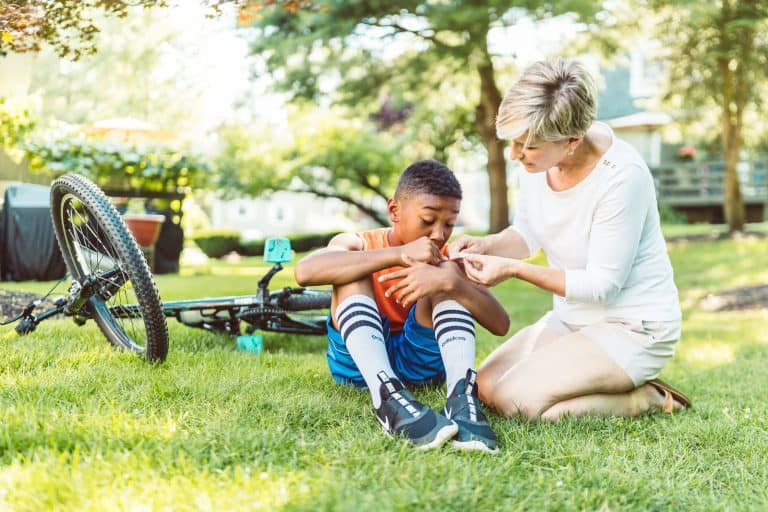As a parent, I’m well aware that kids are full of surprises, and not all of them are pleasant. Scrapes, falls, and the occasional fever are all part of the parenting package. That’s why I believe it’s crucial to arm ourselves with basic first aid skills. Trust me, they can be a game-changer in those heart-stopping moments.
In the blink of an eye, a child’s mischievous adventure can turn into a medical emergency. Knowing how to react can mean the difference between panic and poise. I’ll walk you through the essential first aid skills every parent should master. Whether it’s handling a minor scrape or responding to a serious injury, you’ll be prepared.
Stay tuned as we dive into the must-know techniques that could one day save your little one’s life. It’s the kind of knowledge you’ll hope to never use, but will be forever grateful to have in your parenting toolkit.
The Importance of First Aid for Parents

When it comes to parenting, being well-versed in basic first aid is not just an advantage; it’s a necessity. In the chaos of a household buzzing with the energy of kids, mishaps are bound to happen, and knowing the right steps to handle these situations is imperative. I’ve come to understand that while prevention is key, having child first aid knowledge is an invaluable part of my parenting toolkit.
First aid for parents encompasses a range of skills that are significant in managing common injuries and emergent health issues. This know-how is vital not only for the well-being of our children but for our peace of mind. Whether it’s a minor head injury, a scrape, or something more serious, immediate and correct medical attention can drastically reduce the severity of an injury. Being equipped with emergency care skills means I can confidently tackle health emergencies until professional help arrives.
Handling Accidents at Home
Home is where we want our children to feel safest, yet it is also the place where most childhood accidents occur. Handling accidents at home involves being prepared with a well-stocked first aid kit and the knowledge to use it effectively. From bumps and bruises to more serious ailments, I’ve learned to address each situation with calm precision.
One crucial factor I always keep in mind is the age of the child when administering care. Head injuries, for instance, can be especially unnerving. Even a minor head injury in a child requires careful observation and sometimes medical assessment. Knowing the signs of a concussion or when to seek further help is part of essential first aid for parents.
Toy Safety Guidelines
Beyond treating injuries, it’s equally essential to be proactive in injury prevention. Toy safety guidelines play a significant role here. As a parent, I ensure that the toys in my home are age-appropriate and free from potential hazards that could lead to injury. Inspecting toys for small parts, sharp edges, or any aspect that could pose a risk is a routine I perform regularly. Furthermore, teaching my children how to play safely is a part of this preventive approach.
Common First Aid Situations for Parents

When we talk about emergency care, parents often think of hospitals, but so much of what we can do happens at home. Being equipped with child first aid and basic first aid knowledge is pivotal for me as a parent. And as much as we dread them, head injuries are some of the most common accidents our children will encounter. I’ve learned that knowing how to assess the severity of a head injury and initiating appropriate home injury treatment quickly is essential. Whether it’s a minor head injury from a tumble or something more alarming, keeping calm and administering the right care can change outcomes drastically.
Of course, handling accidents at home isn’t just about knowing what to do in a crisis—it’s also about prevention. That’s where toy safety guidelines come into play. Children are naturally drawn to play, but as parents, it’s our job to ensure that their environment is as safe as possible. Here’s a quick primer on how to keep playtime safe:
- Regularly inspect toys for sharp edges or small parts that could become choking hazards
- Follow the manufacturer’s age recommendations
- Store toys appropriately to prevent trips and falls
Toy Safety Guidelines
I make it a practice to be vigilant about toy safety guidelines. It’s not just about sweeping up the legos to save my own feet—it’s about foreseeing potential hazards that could lead to more serious injuries. By adhering to guidelines, I’ve noticed fewer cuts and bruises during playtime—and my peace of mind is worth every effort.
Let’s say a toy does cause an injury. As a parent, I’ve ensured my first aid kit is always within reach and well-stocked. The right supplies can mean the difference between a minor mishap and a mad dash to the ER. For example, when my child suffered from a cut, I knew that clean gauze and pressure could manage the bleeding until we could get further care.
In developing my aid skills, I recognize the importance of preparedness. While no parent can predict every bump and scrape, I can attest that being armed with the right knowledge and tools—like a comprehensive first aid kit—makes all the difference when those common childhood accidents do occur.
Basic First Aid Skills Every Parent Should Know
As a seasoned blogger in family health and safety, I can’t stress enough the importance of being equipped with basic first aid skills. Handling accidents at home or anywhere else when you’re with your kids requires a calm and knowledgeable response. Child first aid is paramount, and every moment counts. Emergency care begins with you, the parent, before professional help arrives.
Handling Head Injuries
I’ve seen my fair share of minor head injuries, which can be quite common with active children. They can occur from simple falls or during play and should never be taken lightly. First aid for parents means starting with assessing the severity of the injury. If it’s a minor head injury, I suggest keeping the child still and applying a cold compress to reduce swelling. Watch for symptoms like drowsiness, vomiting, or disorientation, which could indicate a need for immediate medical attention.
Head injuries can vary from simple bumps to serious trauma. So the rule of thumb for parents is: When in doubt, get it checked out.
Toy Safety Guidelines
Toy safety plays an essential role in preventing needless accidents. To prevent injuries, you should always:
- Choose age-appropriate toys.
- Inspect toys for sharp edges and loose parts.
- Supervise play, particularly with younger children.
By adhering to toy safety guidelines, you’re proactively reducing the risk of injuries that might require First Aid intervention.
Equipping Your First Aid Kit
No conversation about first aid skills is complete without a mention of the first aid kit. This kit is your first line of defense and should be well-stocked and readily available. Key items include:
- Sterile gauze
- Adhesive bandages
- Antiseptic wipes
- Cold packs
- Tweezers
- Safety scissors
- Emergency contact numbers
Whether you’re dealing with a scraped knee or a more serious incident, having these supplies at your fingertips is vital. Make sure to check your kit regularly and replace any used or expired items.
Everyday scenarios such as home injury treatment underscore the necessity of having a solid grasp on basic first aid. As I continue to navigate parenthood, I realize the significance of these skills in building a safer environment for children. The peace of mind that comes from being prepared isn’t just for the well-being of your children, but for your own tranquility as a parent, too.
How to Handle Minor Scrapes and Cuts

Dealing with minor injuries is an inevitable part of parenting. It’s essential that I’m skilled in child first aid, especially when it comes to treatment of minor ailments at home. In my years of experience as a parent, I’ve learned that mastering basic first aid can significantly alleviate the stress of handling accidents at home. When it comes to minor scrapes and cuts, there are effective ways to provide emergency care without needing to rush to the hospital.
Immediate Care Steps
The moment a child comes to me with a fresh scratch or cut, it’s crucial to act promptly and efficiently. The first aid for parents starts by ensuring that my hands are clean to avoid introducing bacteria into the child’s wound. Here’s the step-by-step approach I always take:
- Rinse my hands with water and use soap to eliminate germs.
- Gently cleanse the wound using soap and water to flush out any debris.
- If there’s bleeding, I apply direct pressure using a sterile gauze or a clean cloth. Elevation of the affected area reduces blood flow and assists in clotting.
Sometimes, the bleeding might be persistent. In such cases, if it doesn’t stop after five minutes of applied pressure, I know it’s time to contact a healthcare professional, which could mean calling my pediatrician or even dialing 911 for immediate assistance.
Preventing Infection
After the bleeding has ceased, preventing infection is my next top priority. I apply an antibiotic ointment liberally to ward off bacteria and cover the wound with an adhesive bandage. This isn’t just about protection — it’s about creating an environment conducive to healing. The bandage should be changed daily or more often if it gets dirty or wet.
Recognizing When to Seek Help
It’s vital to recognize when an injury is beyond the scope of home injury treatment. Signs of infection such as increased redness, warmth, swelling, or pus require medical attention. Fever or severe pain accompanying a wound also warrants a trip to the doctor.
Toy Safety Guidelines
Part of preventing injuries involves ensuring safe play. While my child’s wellbeing is my main concern, being proactive about toy safety can minimize the chances of accidents. I always:
- Check toys for sharp edges or small parts that can cause cuts or become choking hazards.
Responding to Serious Injuries: When to Call 911

Emergencies can happen in the blink of an eye, especially with children around. It’s crucial that I, as a parent, know exactly when to seek emergency care for my child.
Recognizing the Signs of Severe Head Injuries
In the case of head injuries, time is of the essence. Immediate action can be life-saving. If my child loses consciousness, even for a moment, or if they show signs of severe distress such as constant crying or an inability to walk normally, it’s clear I need to call 911 right away. These could be signs of a serious head injury or concussion. Moreover, symptoms like seizures, sudden uncoordination, an inability to move a limb, slurred speech, or fluids leaking from the ears or nose are all red flags that demand emergency medical attention without delay.
Here’s a checklist to keep in mind if I suspect a serious injury:
- Loss of consciousness
- Persistent crying
- Trouble walking
- Seizures
- Sudden lack of coordination
- Inability to move a body part
- Slurred speech
- Fluids from ears or nose
Home Injury Treatment and Safety Precautions
When home injury treatment is needed for less serious cases, I’m always ready with a well-stocked first aid kit. For minor scrapes and bruises that don’t require medical care, cleaning the wound and applying a sterile bandage is often enough. But knowing when a situation is beyond basic first aid is a critical aid skill every parent should possess.
Reacting Under Pressure
Parenting often throws unexpected challenges our way, and when faced with a sudden injury or accident, the ability to remain calm is paramount. In these critical moments, it’s essential to remember some basic first aid tips to ensure effective and composed responses. Whether it’s a minor scrape or a more serious incident, staying level-headed can make a significant difference in the outcome.
By keeping emergency services on speed dial and being familiar with the nearest emergency room, parents can expedite the process of seeking professional help when necessary. The keyword “remain calm” takes center stage here, as maintaining composure is not just a virtue but a crucial skill in managing unexpected health crises.
Knowing When to Seek Professional Help
While basic first aid skills empower parents to address many situations, there are instances where immediate emergency medical care is indispensable. Recognizing when a child has lost consciousness, experiences persistent distress, or shows signs of severe injury is a clear signal to activate emergency services. In such cases, the keyword “lose consciousness” becomes a critical trigger for action. Understanding the importance of swift response and knowing when to call for professional assistance ensures that parents are equipped to handle a broad spectrum of scenarios, fostering a safer environment for their children.
Take Away
Arming myself with first aid knowledge has been empowering—it’s a vital skill set that lets me respond confidently to my children’s bumps and bruises. I’ve learned that being prepared isn’t just about having band-aids and antiseptics on hand; it’s about understanding the nuances of various injuries and when professional medical intervention is necessary. Remembering the importance of toy safety can’t be overstated either as it’s a proactive step towards preventing many common accidents. As I continue to navigate parenthood, these skills are not just handy—they’re essential for ensuring my kids’ well-being and my peace of mind.
Other suggested articles:

